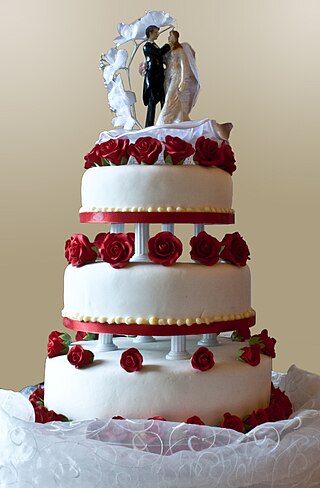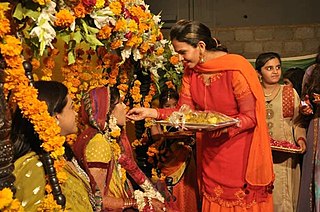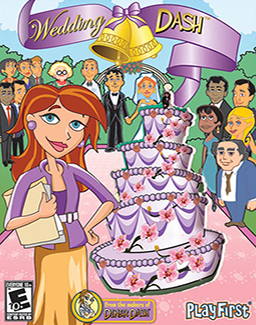
A wedding is a ceremony where two people are united in marriage. Wedding traditions and customs vary greatly between cultures, ethnic groups, religions, countries, and social classes. Most wedding ceremonies involve an exchange of marriage vows by a couple, presentation of a gift, and a public proclamation of marriage by an authority figure or celebrant. Special wedding garments are often worn, and the ceremony is sometimes followed by a wedding reception. Music, poetry, prayers, or readings from religious texts or literature are also commonly incorporated into the ceremony, as well as superstitious customs.
A white wedding is a traditional formal or semi-formal wedding originating in Great Britain.

A wedding reception is a party usually held after the completion of a marriage ceremony as hospitality for those who have attended the wedding, hence the name reception: the couple receive society, in the form of family and friends, for the first time as a married couple. Hosts provide their choice of food and drink, although a wedding cake is popular.

A wedding cake is the traditional cake served at wedding receptions following dinner. In some parts of England, the wedding cake is served at a wedding breakfast; the 'wedding breakfast' does not mean the meal will be held in the morning, but at a time following the ceremony on the same day. In modern Western culture, the cake is usually on display and served to guests at the reception. Traditionally, wedding cakes were made to bring good luck to all guests and the couple. Nowadays, however, they are more of a centerpiece to the wedding and are not always even served to the guests. Some cakes are built with only a single edible tier for the bride and groom to share, but this is rare since the cost difference between fake and real tiers is minimal.

A groomsman or usher is one of the male attendants to the groom in a wedding ceremony. Usually, the groom selects close friends and relatives to serve as groomsmen, and it is considered an honor to be selected. From his groomsmen, the groom usually chooses one to serve as best man.
The money dance, dollar dance, or apron dance is an event at some wedding receptions in various cultures. During a money dance, male guests pay to dance briefly with the bride, and sometimes female guests pay to dance with the groom.

The traditional Vietnamese wedding is one of the most important ceremonies in Vietnamese culture, which is influenced by Confucian and Buddhist ideologies.

A Bengali Muslim wedding A true Bengali Muslim wedding includes very few rituals and ceremonies that may span to three days max. In most cases, it starts with the Paka Dekha ceremony. Then, nikkah which is done by a kaji with a fixed denmohor and it ends with the Bou Bhat ceremony that is popular as the wedding reception arranged by the groom's family.
Iranian wedding, also known as Persian wedding, consists of traditions that go back to Zoroastrianism, which was the main religion of pre-Islamic Iran, and although the concepts theories of marriage have been changed by Islamic traditions, the ceremonies have remained more or less the same as they were originally in pre-Islamic Iran. Although modern-day Iran is a multi-ethnic country, Iranian wedding traditions are observed by the majority of ethnic groups in Iran.

Marriage in Pakistan pertains to wedding traditions established and adhered by Pakistani men and women. Despite their local and regional variations, marriages in Pakistan generally follow Islamic marital jurisprudence. Marriages are not only seen as a union between a husband and a wife, but also an alliance between their respective families. These traditions extend to other countries around in the world where Overseas Pakistani communities exist.

Punjabi wedding traditions are a strong reflection of Punjabi culture with ritual, song, dance, food, and dress that have evolved over centuries.

A groom's cake is a wedding tradition that originated in Victorian England, but in the modern age it is more frequently observed in the American South. While a wedding cake may often be light in texture or color and decorated in white, the groom's cake can take a variety of forms. Many incorporate chocolate or fruit. Cheesecake sometimes serves as a groom's cake. The groom's cake is often served at a table separate from the wedding cake at a wedding reception or wedding breakfast, though it may be served as a dessert for a rehearsal dinner.

A traditional Russian wedding can last between two days and one week. The celebration involves dancing, singing, toasting, and banqueting. The best man and maid of honor are called Witnesses or Свидетели in Russian. The ceremony and the ring exchange take place on the first day of the wedding. Russian weddings are unique matrimonial ceremonies that have undertaken some western traditions, including incorporating bridesmaids into the wedding party.

Wedding Dash is a series of strategy casual video games by PlayFirst. It was released on October 18, 2007 as a spin-off to the Diner Dash series of games.
Arabic weddings are ceremonies of matrimony which contain Arab influences or Arabic culture.
In the United States and Canada, weddings follow traditions often based on religion, culture, and social norms. Most wedding traditions in the United States and Canada were assimilated from other, generally European, countries. Marriages in the U.S. and Canada are typically arranged by the participants and ceremonies may either be religious or civil. There is a tradition that the prospective bridegroom ask his future father-in-law for his blessing.

Traditional marriage customs in the Philippines and Filipino wedding practices pertain to the characteristics of marriage and wedding traditions established and adhered by them Filipino men and women in the Philippines after a period of adoption courtship and engagement. These traditions extend to other countries around the world where Filipino communities exist. Kasalan is the Filipino word for "wedding", while its root word – kasal – means "marriage". The present-day character of marriages and weddings in the Philippines were primarily influenced by the permutation of Christian, both Catholic and Protestant, Hindu, Islam, Chinese, Spanish, and American models.
An Oaxacan wedding is a traditional ritual that involves the participation of both the bride's and groom's family along with the community. The main decision makers of the wedding are the fathers of the groom and bride. The father of the groom must first ask for the bride's hand and if the bride's father accepts two weeks later they begin to arrange the wedding. If the case is that the groom does not have a father he can have an elder represent him. At this gathering the groom's side of the family brings with them fruits, bread, and alcoholic beverages. The godparents of both the bride and groom attend this gathering, who are the godparents of baptism, first communion, confirmation, as well as the new wedding godparents of the couple. The godparents are chosen by the couple usually because of a blood tie or a friendship. After this the groom must show his commitment to his bride's family by doing any chores the bride's family needs until the wedding date. The chores can vary from sweeping to helping the father in law with work in the ranch.

A wedding is a celebratory ceremony where two people are brought together in matrimony. Wedding traditions and customs differ across cultures, countries, religions, and societies in terms of how a marriage is celebrated, but are strongly symbolic, and often have roots in superstitions for what makes a lucky or unlucky marriage. Superstition is often linked to practices involving luck, fate or prophecy, and while many weddings are now more focused on celebratory traditions, many are still practiced, and numerous well-known wedding traditions have roots in superstitions from previous ages. A common example of a superstition involves no one seeing the bride in her wedding dress until the ceremony.












